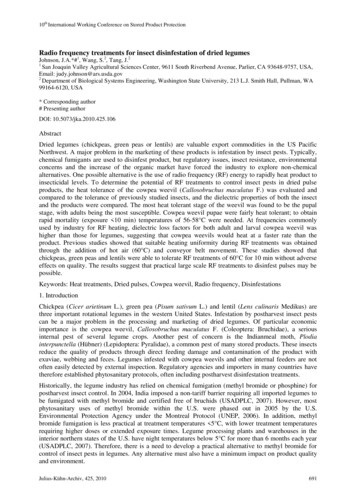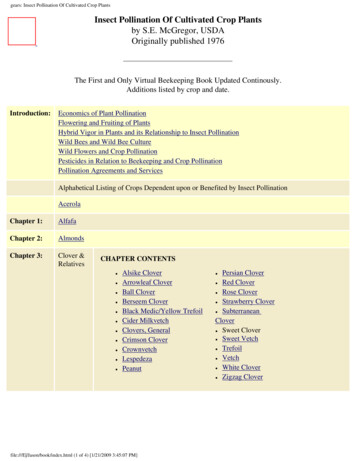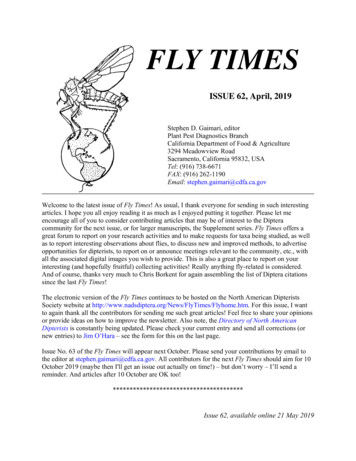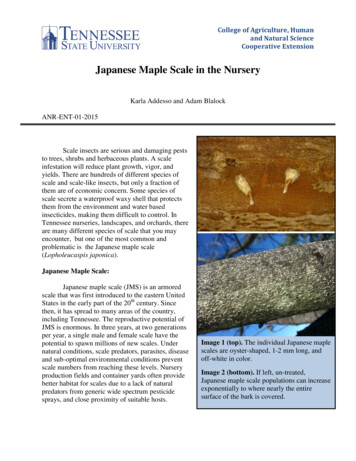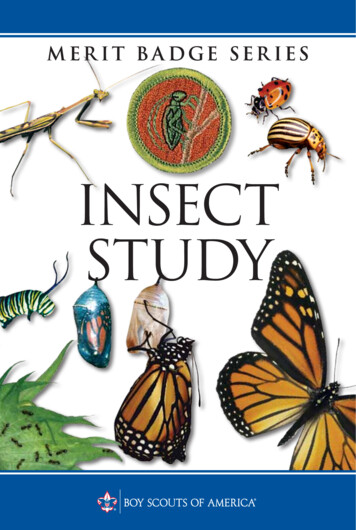
Transcription
insectstudy
How to Use This PamphletThe secret to successfully earning a merit badge is for you to use boththe pamphlet and the suggestions of your counselor.Your counselor can be as important to you as a coach is to an athlete.Use all of the resources your counselor can make available to you.This may be the best chance you will have to learn about this particularsubject. Make it count.If you or your counselor feels that any information in this pamphlet isincorrect, please let us know. Please state your source of information.Merit badge pamphlets are reprinted annually and requirementsupdated regularly. Your suggestions for improvement are welcome.Send comments along with a brief statement about yourself to YouthDevelopment, S209 Boy Scouts of America 1325 West Walnut HillLane P.O. Box 152079 Irving, TX 75015-2079.Who Pays for This Pamphlet?This merit badge pamphlet is one in a series of more than 100 coveringall kinds of hobby and career subjects. It is made available for youto buy as a service of the national and local councils, Boy Scouts ofAmerica. The costs of the development, writing, and editing of themerit badge pamphlets are paid for by the Boy Scouts of America inorder to bring you the best book at a reasonable price.
BOY SCOUTS OF AMERICAMERIT BADGE SERIESinsect study
Requirements1. Tell how insects are different from all other animals.Show how insects are different from centipedes and spiders.2. Point out and name the main parts of an insect.3. Describe the characteristics that distinguish the principalfamilies and orders of insects.4. Do the following:a. Observe 20 different live species of insects in theirhabitat. In your observations, include at least fourorders of insects.b. Make a scrapbook of the 20 insects you observe in 4a.Include photographs, sketches, illustrations, and articles.Label each insect with its common and scientific names,where possible. Share your scrapbook with your meritbadge counselor.Yellow-legged meadowlark35911ISBN 978-0-8395-3353-5 2008 Boy Scouts of America2010 PrintingBANG/Brainerd, MN5-2010/060104
5. Do the following:a. From your scrapbook collection, identify three speciesof insects helpful to humans and five species of insectsharmful to humans.b. Describe some general methods of insect control.6. Compare the life histories of a butterfly and a grasshopper.Tell how they are different.7. Raise an insect through complete metamorphosis fromits larval stage to its adult stage (e.g., raise a butterflyor moth from a caterpillar).*8. Observe an ant colony or a beehive. Tell what you saw.9. Tell things that make social insects different fromsolitary insects.10. Tell how insects fit in the food chains of other insects,fish, birds, and mammals.11. Find out about three career opportunities in insectstudy. Pick one and find out the education, training,and experience required for this profession. Discussthis with your counselor, and explain why thisprofession might interest you.Cricket* Some insects are endangered species and are protected by federal or state law.Every species is found only in its own special type of habitat. Be sure to checknatural resources authorities in advance to be sure that you will not be collecting any species that is known to be protected or endangered, or in any habitatwhere collecting is prohibited. In most cases, all specimens should be returnedat the location of capture after the requirement has been met. Check with yourmerit badge counselor for those instances where the return of these specimenswould not be appropriate.Insect Study3
ContentsThe World of Insects. . . . . . . . . . . . . . . . . . . . . . . . . . . . . . . 7What Is an Insect? . . . . . . . . . . . . . . . . . . . . . . . . . . . . . . . . 13Parts of an Insect. . . . . . . . . . . . . . . . . . . . . . . . . . . . . . . . . . 17Insect Safari . . . . . . . . . . . . . . . . . . . . . . . . . . . . . . . . . . . . . 33Identifying Insects. . . . . . . . . . . . . . . . . . . . . . . . . . . . . . . . . 47The Life of an Insect. . . . . . . . . . . . . . . . . . . . . . . . . . . . . . . 55The Social Insects. . . . . . . . . . . . . . . . . . . . . . . . . . . . . . . . . 63Insects and Humans . . . . . . . . . . . . . . . . . . . . . . . . . . . . . . . 75Careers in Entomology. . . . . . . . . . . . . . . . . . . . . . . . . . . . . 87Insect Study Resources . . . . . . . . . . . . . . . . . . . . . . . . . . . . . 93Walking stickInsect Study5
.The World of InsectsThe Worldof InsectsHiking in the woods or fields ona summer day, you are sure tosee dozens, perhaps hundreds, ofinsects. Many are so tiny and seemso insignificant (except when they biteyou) that you might dismiss them simply asnuisances. If you do, you are missing a chanceto explore a world of unbelievable variety, filled withmarvels hard to imagine.Get ready to meet tiny creatures with tremendous strengthand speed. You will see insects that undergo startling changesin habits and form as they grow. You will learn how insects see,hear, taste, smell, and feel the world around them; how theyfind food; and how some of them live together in amazinglycomplex societies. You will learn about insects that are helpfulto humans and others that are harmful or even deadly.The field of insect study is as broad as all outdoors andjust as open. Entomologists, scientists who study insects, havedescribed about 1.5 million different insects, each a distincttype known as a species. Scientists discover from 7,000 to10,000 new species of insects every year. They estimate thatthere are between 1 million and 10 million species still undiscovered. However, research in the Amazon region of SouthAmerica has led some scientists to think there could be asmany as 30 million insect species worldwide.Clearly, much remains to be learned about insects. Whileworking on the requirements for this merit badge, you might discover something about insects that no one ever knew. Rememberthat you are welcome to watch and study insects wherever youfind them, but it is illegal to collect insects in many naturalareas, especially state parks, national parks, and wildlife refuges.Insect Study7
The World of Insects.Extreme InsectsExtremely strong: An ant can lift50 times its own body weight.If a 180-pound man could dothat, he could lift 9,000 pounds—41 2 tons!Red fire antExtremely fast: Dragonflies canfly 60 miles per hour. A housefly’swings beat about 200 times asecond (the buzzing of a fly isthe sound of its wings beating).Some midges move their wings1,000 times a second.DragonflyExtremely nimble: A flea canbroad jump about 13 inches.By comparison, a human athletewould have to jump 700 feet toequal the flea’s performance.Cat flea8Insect Study
.The World of InsectsExtremely big: Goliath beetlesgrow to about 5 inches long.Australia’s giant Hercules mothand South America’s giant owlmoth have wingspreads of about12 inches. The Queen Alexandra’sbirdwing butterfly has a wingspread of about 11 inches. Someextinct dragonflies were 18 incheslong with wingspans of 21 2 feet.Goliath beetleExtremely small: Fairyflies andfeather-winged beetles couldeasily pass through the eye ofthe smallest needle. The glassywinged sharpshooter is a tinyinsect as well, growing to ahalf-inch at most.Glassy winged sharpshooterExtremely colorful: Butterflies areevery color imaginable, frombright yellows, reds, and orangesto shimmering coppers; pale,silvery blues; and pearly whites.Some beetles are a rainbowof brilliant metallic orjewel-tone shades.Eastern tiger swallowtailInsect Study9
The World of Insects.Extremely smelly: Stinkbugs,some beetles, and lacewingsemit foul odors to repel enemies.The bombardier beetle fendsoff attackers by squirting twochemicals from the end of itsbody. The chemicals mix toproduce a hot puff of gas.Brown stinkbugSilverfishExtremely ancient: Insects first appeared on Earthin prehistoric times. Dragonflies flitted through theskies and silverfish and cockroaches scurried on theground while dinosaurs walked the land.Extremely versatile: Among insects there arebuilders and carpenters, hunters and trappers, farmersand livestockraisers, nurses,guards, soldiers,papermakers,sanitation workers, slaves, andeven thieves.AmericancockroachTexas leafcutting ant10Insect Study
.The World of InsectsExtremely adaptable: Insects are everywhere—in trees and forests,in grasslands, in deserts, on mountains, in lakes, in the air, on buses,in homes and offices. The young of some insects can live in pools ofcrude oil. Some live in hot springs at temperatures of 120 degrees.Others live in ice-cold streams, even above the Arctic Circle. After beingfrozen and thawed, some insects will revive unharmed. Some insectslive in caves deep within Earth, or between the thin walls of a leaf.The only place you are not likely to find many insects is in the oceans.Insect Study11
Bush katydid
.What Is an Insect?What Is an Insect?There are more insects in the world than all other animals combined; 75 percent of all animal species are insects. They comein every imaginable size, shape, description, and color. Mostinsects pass through life stages during which they look quitedifferent from their adult forms. Given the enormous numberand variety of these creatures, it might seem difficult to sayexactly what an insect is. Nevertheless, all insects have certainthings in common that make them recognizable.All insects belong to a larger animal group known asarthropods, which also includes spiders, mites, ticks, scorpions,harvestmen (daddy longlegs), crabs, shrimp, crayfish, sowbugs, barnacles, centipedes, and millipedes. All of these relatedanimals share two unique characteristics that distinguish themfrom all other animal groups. Arthropods have Jointed legs An external skeleton—the exoskeleton—encloses the entirebody in a shellDifferences in body structure separate the insects fromtheir arthropod relatives. Insects have six jointed legs (threepairs); all other arthropods have four or more pairs of legs.Insect bodies are divided into three distinct regions—head,thorax, and abdomen; most other arthropods have only twobody regions—head and trunk. Insects have one pair of antennae or “feelers”; spiders and their relatives have no antennae,while crustaceans (crabs, shrimp, crayfish, etc.) have two pairs.Most adult insects have wings; no other arthropod has wings atany stage of life.Insect Study13
What Is an Insect?.Identifying insects fromother arthropods and smallanimals gets easier with experience. For example, a caterpillaryou see feeding on a leaf mightnot look like an insect becauseit appears to have more thansix legs. However, it actuallyhas six jointed legs and 10fleshy, unjointed accessory legscalled prolegs. When the caterpillar (larvae stage) transformsinto an adult butterfly, you willhave no doubt about thenumber of legs it has.Black swallowtail caterpillarBlack swallowtail adult butterfly14Insect Study
.What Is an Insect?AntRemember these identifying characteristics: Insects have an external covering called an exoskeleton (a shell). Insects have three body regions, six jointed legs, and one pairof antennae. Adult insects usually have wings.Insect Study15
.Parts of an InsectParts of an InsectCompare a bumblebee, a grasshopper, and a butterfly. Theydiffer in many ways, but they share the same general bodystructure. While their body parts might differ in size and shape,they and all other insects are put together in the same way.Insect Body RegionsThe insect body has three distinct regions—head, thorax, andabdomen. The prominent features of the head are the eyes,antennae, and mouthparts. Attached to the thorax are the legsand, when they are present, the wings. The abdomen containsmany of the important internal organs, such as the reproductiveand digestive n a few insects, the thorax and abdomen might appear torun together. The jointed legs, however, are always attached tothe thorax. The area where the last leg is attached is the pointwhere the thorax ends and the abdomen begins.Insect Study17
Parts of an Insect.The Insect’s ArmorAn insect’s exoskeleton, or shell, is formed of plates fittedtogether like the armor of a medieval knight. Insects have nobones—no internal skeleton such as humans have. Muscles andother body tissues are attached to the inside of the exoskeleton.The exoskeleton is made of chitin (KY-tuhn), a light, strongmaterial. Every insect lives encased in chitin, although shellthicknesses vary. Exoskeletons of caterpillars form thin skins;beetles have thick, armorlike plates.Cicada nymphs hatch fromeggs laid in trees. Theyoung insects burrow intothe ground and suck sapfrom roots, staying buriedfor up to 17 years. Whenthey do come back out,they crawl up trees, shedtheir old exoskeletons,and emerge as full-grownadults ready to lay eggsand keep the cycle going.As an insect grows, its skin becomes too tight and splits—it molts, or sheds its skin. The chitinous exoskeleton splitsdown the back, and the insect emerges from its old skin andexpands into a new, larger one. The number of molts needed toreach adult form and size varies from four to 40, depending onthe species.An insect’s body structure is related to its senses ofsight, smell, hearing, taste, and touch, and to how itmoves about, eats, and breathes.18Insect Study
.Parts of an InsectHow an Insect SeesMost insects have two kinds of eyes: compound eyes forseeing detail and simple eyes for perceiving brightness.OmmatidiumLensPraying mantisSimple eyesPhotoreceptorsCompound eyeIn the compound eye, six-sided lenses calledommatidia contribute to the complete image the insectsees. A large dragonfly can have as many as 28,000ommatidia in each compound eye. Some queen antshave about 50 lenses; some robber flies, 4,000; aswallowtail butterfly, 17,000. These large compoundeyes bulge outward, allowing insects to see up, down,forward, backward, and to each side.Nerve fibersto brainCompound eye of a fruit flyHead of fruit flyOMMAtidiaEYEInsect Study19
Parts of an Insect.Insects cannotfocus their eyesfirst on distantobjects and thenon near ones,as we can. Theireyes are likeThe simple eyes, called ocelli, are set in a triangulararrangement between the compound eyes. Simple eyes seemto help the insect detect changes in brightness rather thanfor actual vision. In some cases, the ocelli are 16 times moresensitive to light changes than are the compound eyes.Insects probably never see the world around them in perfect focus. They see objects, but probably not in sharp detail.A dragonfly will dart at bits of floating ash above a campfire,evidently mistaking them for insects on the wing. A wasp mightdart repeatedly at the shadow of a fly resting on the otherside of a canvas tent. Butterflies will rush at a decoy cut fromcolored paper as readily as at another butterfly.fixed-focuscameras. Insectscan, however,see “black light,”the ultraviolet raysinvisible to humans.Insects can see and remember different colors. TheEnglish scientist Lord Avebury proved this in a classicexperiment. He placed a little honey on a blue squareamong squares of other colors. After bees began tocome daily to this square for food, he shuffled thesquares and put food on none of them. Instead offlying to the square that lay where the blue squareused to be, the bees immediately landed on the bluesquare even though it was in an entirely differentposition. They associated the color with food, provingthey could see and remember blue as a color.When a bee flies in a “beeline” home to the hive, it navigates largely by using its eyes, recognizing landmarks along theway. If the same bee is carried into country it has never seenbefore, it is lost. Similarly, wasps find theirway back to their nests or burrows by eyesight. If you place a leaf over the entranceof a digger wasp’s burrow, the wasp will beconfused when it returns because the spotlooks different. One scientist found thatwhen he cut off a small bush near theentrance of a wasp’s burrow and stuck it inthe ground several yards away, the waspflew to the bush instead of to the burrow.It was using the bush as a landmark.Digger wasp20Insect Study
.Parts of an InsectHow an Insect SmellsAn insect’s antennae function as its nose. Compare a damselflywith a male cecropia moth. The damselfly has immense eyesbut small, spikelike antennae. The moth has small eyes butlarge, fernlike feelers. The damselfly depends on sight to guideit; the cecropia, flying in darkness, follows its feelers along faintodor trails through the night.Eastern forktail damselflyMale cecropia mothSome ichneumons (ik-NOO-muhn), insect parasitesthat lay their eggs on tree-boring grubs, have suchan amazingly keen sense of smell that they can detectthe odor of their prey through 2 inches of solid wood.In the antennaeof one junebeetle, scientistsfound 40,000 tinyolfactory pits fordetecting odors.Laboratory testshave proventhat honeybeescan distinguishmore than40 different odors.Insect Study21
Parts of an Insect.Larvae are young,immature insects.The larvae ofbutterflies andmoths arecalled caterpillars.Unlike bees and wasps, the earthbound ant seems to depend onsmell rather than sight to find its way. Ants leave odor trails onthe main routes around their nests. As long as its antennae areintact, an ant can follow these scent trails. Without its antennae,the insect is completely lost, even if placed close to the entranceof its home.Like a radio tuned to one station, the sense of smell inmany insects seems limited to a narrow range of odors. A malemoth, traveling through miles of darkness to reach the female,seems insensitive to the thousands of other smells around it.Carrion beetles, which appear as if by magic when a fallensparrow or dead mole begins to decompose, are led to the spotfrom far away by their sensitive feelers. All other smells seemnot to affect them. Butterflies and moths follow their sense ofsmell to plants that will provide the right kind of food for theirlarvae. The females are “tuned in” to that particular smell.22Insect Study
.Parts of an InsectFeeling Their BestABCDAntennae of (A) butterfly; (B) skipper; (C) moth;and (D) saturniid mothThe antennae ofdifferent insects varygreatly in shape andsize. They range fromthe slender, threadlikefeelers of katydidsand long-hornedgrasshoppers to thestubby spikes of robberflies. Ants and beeshave jointed, elbowedDelaware skipperfeelers; butterflies haveantennae that resemble long-handled clubs; gnats andmosquitoes have bristly feelers that look like miniaturebottle brushes. With such feelers, mosquitoes find theirfood in the dark.Only femalemosquitoes bitepeople; malesdine on thenectar of flowers.Insect Study23
Parts of an Insect.Asian tiger mosquitoHow an Insect HearsAmong allthe ,crickets, cicadas),only the males—never the females—make music.24Insect StudyBesides detecting odors, the bushy antennae of some mosquitoes and gnats help catch certain sounds. To demonstrate this,a scientist fastened a live male mosquito to a microscope slide,then held a tuning fork with exactly the same pitch as the humof a female mosquito to the right of the male. Instantly, thehairs on the male’s right antenna began to quiver. The scientistheld the tuning fork to the left of the male mosquito. The hairson the left antenna vibrated. When the tuning fork was held infront of the insect, the hairs on both antennae quivered. Like anairplane pilot flying on a radio beam, the male insect can findthe female in the dark. To stay on course, he has only to keepthe hairs on both his feelers vibrating equally. That will leadhim to the humming female.Other insects hear in different ways. A cricket’s ears areon its forelegs, just below the knees, as are a katydid’s. Youcan easily see these oval openings, called tympana, when theinsects are at rest. The ears of short-horned grasshoppers, orlocusts, are on the sides of their bodies near the base of thewings. Many species, including honeybees, ants, and dragonflies, give no sign that they hear sounds the way humans do.However, they certainly feel vibrations within the range thatwe call sound.
.Parts of an InsectMany insectsounds are associatedwith the mating season.The song of the snowy treecricket, the fiddling of thekatydid, the chirping of the fieldcricket, the loud burr of the cicada,even the ticking of the deathwatch beetle as itbumps its head against the walls of a tunnel ithas hollowed out in a house timber—all of theseare serenades to attract females. In a laboratory experiment, afemale field cricket was drawn to a telephone receiver 30 feetaway when she heard the chirps of a male cricket at the otherend of the line.Cicada withwings spreadHow an Insect Tastes and EatsMany insects react to the same four kinds of taste—salty, sour,sweet, and bitter—that people can identify. Some insects areespecially sensitive to certain tastes. A honeybee, for example,will react to faint traces of salt that a human tongue cannotdetect. A monarch butterfly can taste sugar dissolved in waterat a level thousands of times weaker than a person can taste.The taste organs of most insects are on their mouthparts,as expected. However, the antennae of ants, bees, and waspshelp them taste, whilesome flies and butterHawk moth with tongue(proboscis) extendedflies can taste withtheir feet. When thelegs of a monarchbutterfly touch nectaror sweetened water,the insect immediatelyuncoils its hollowtongue—itsproboscis—to feed.Insect Study25
Parts of an Insect.The prayingmantis haspowerful jawsfor devouringits prey.Butterflies and moths, with their coiled sucking tubes, take only liquid nourishment, mainlynectar. The paper wasp, with jaws and a tongue,can lap up nectar or chew captured insects tofeed to the larvae in its nest. Plant lice andsquash bugs havesharp, sucking beaksfor drawing sap fromplant tissues, as doesthe tiny froghopper.Beetles, crickets, andgrasshoppers havejaws for chewingleaves and other solidfood. The jaws, ormandibles, worksideways insteadA grasshopper’s strong jaws help it chew.of up and downlike the jaws ofhigher animals.How an Insect FeelsTiny hairs and spines connected with its nervous system give aninsect a delicate sense of touch. These touch organs cover allparts of an insect’s body, even its eyes. Ants and other earthhugging insects such as crickets, earwigs, and cockroaches havespines that are particularly sensitive to vibrations. Some butterflies have a fringe of sensory hairs along the margins of theirwings. Water striders can use the fine hairs on their feet to sensethe approach of their prey through vibrations of the water’ssurface film. Tiny hairs on the leg joints of some insects—hairsthat are bent when the legs move—enable the insects to tell theposition of their limbs. In contrast, we humans tell the positionof our legs by the “feel” of the muscles.The central nervous system in insects consists of a brain,located in the head, and two nerve cords that lie side by sidealong the lower side of the body cavity. This position of thenerve cords is opposite to the placement of the spinal cord inhigher animals.26Insect Study
.Parts of an InsectHow an Insect Moves AboutInsects travel on the ground, underground,underwater, and in the air. Many have odd andoften surprising means of travel that fit them forthe place where they live. Dragonfly naiads, forinstance, sometimes move like miniature rocketsalong a pond bottom by expelling jets of waterfrom their rears. This drives them ahead insudden spurts.Primitive insects known as springtails havea forked, taillike appendage that can be bent andthen suddenly released like a spring to catapultthe insect into the air. Springtails are so light thatsome of them shoot into the air from the surfacefilm of ponds or streams. The most spectacularare the so-called snow fleas. In mild midwinterweather, these curious black insects sometimesappear on snowdrifts in such numbers that theylook like clouds of windblown soot.Dragonfly naiadA naiad is theimmature,water-living formof insects suchas mayfliesand dragonflies.Mature calico pennant dragonflyInsect Study27
Parts of an Insect.Praying mantisPeriodical cicada nymphCamel cricketLegsHousefly28Insect StudyThe legs of insects suggest the kind of life they lead. Molecrickets and the nymphs (larvae) of periodical cicadas haveforelegs enlarged into powerful digging tools. The long, spikedforelegs of the praying mantis are spined traps for capturingprey. Houseflies have feet with sticky pads that help them walkon smooth panes of glass or upside down on ceilings. Robberflies—insect predators that swoop down on victims and grabthem in midair with their feet—have unusually long legs endingin hooked claws. Dragonflies are almost completely aerialcreatures; they form their spined legs into a basket to catchprey in flight. Their legs are bunched so far forward that theyare almost useless for walking, and are used mostly for clingingand climbing. Some water beetles have legs that work like oars.
.Parts of an InsectWater striders walk on the surface film on water-repellent tufts ofhair that spread fanwise near the tips of their legs, like snowshoes.When not in use, the hairs fold up into a slot on the insect’s leg.A Solid FootingTo find out how insects use their six legs to walk,watch a large insect from above when it is chilledand moving slowly. The insect walks on a series oftripods, the front and hind legs on one side and themiddle leg on the opposite side movingin unison. Thus, like a three-legged stoolit is always firmly planted, never offbalance. An exception is the monarchbutterfly, which walks on only four ofits legs. The front pair is carried foldedagainst its body.Bark beetleInsect Study29
Parts of an Insect.WingsSome butterfliescan reachheights of almost20,000 feet.Most insects have two pairs of wings, a few have one pair, andsome have no wings at all. Only adult insects have wings; awinged insect is fully mature, with the exception of the subadults (or subimagoes) of mayflies.In the air, some insects reach high speeds and highaltitudes and travel great distances. Their wings operate differently from the wings of birds. Instead of the flapping or rowingmotion of a bird, the wings of an insect usually move in aseries of figure eights. The English scientist Lord Avebury wasthe first to demonstrate this motion. He tipped the wings of awasp with gold leaf and let the insect fly in sunlight. The tinyspots of shining gold traced figure eights in the air. On wingsmoving in this fashion—often so fast they are blurs to oureyes—many insects can outmaneuver birds. They can stop inmidair, turn, go straight up, drop to the ground, and, in somecases, even fly backward.The wing muscles of flying insects are the largest intheir bodies. In one kind of fly, the wing muscles account for48 percent of the insect’s body weight. These great muscleschange the whole shape of the thorax, causing the wings tomove up and down. Other special muscles are used to manipulate the wing to change direction, or to fold the wing when theinsect is at rest.When wasps, butterflies, and bees take to the air, the hindpair of wings attaches to the front pair so that the insect flies asthough it had only a single pair of wings. This is done in various ways. In wasps and bees, small rows of twisted hooks onthe front edges of the hind wings engage little ridges on thetrailing edges of the forewings.Dragonflies, which have four wings, usea different flying technique than mostinsects. The two pairs of wings are keptseparate and move independently.
.Parts of an InsectHow an Insect BreathesAn insect has no lungs,but it still must breathe.Air enters throughopenings in the bodycalled spiracles, anda system of finelybranching tubes, ortracheae, carriesoxygen directly to bodytissues. The droningof some flies is thehumming sound madeThe spiracles are easy to see on theby air entering thesesides of a tobacco hornworm.breathing tubes.Most insects need little oxygen. The most active fliers,however, such as dragonflies, bees, and moths, have small,bladderlike reservoirs connected to air tubes. These reserve“gas tanks” hold extra supplies of air. A dragonfly breathesabout 118 times a minute; some humans average about18 times a minute. Less active species of insects breathemore slowly.Many diving, air-breathing aquatic insects have a thickcoating of fine hair, or pile, on the underside of their bodies.It is called the plastron. Air catches in this pile and is carriedalong when the creature dives. By carrying its own oxygensupply, the insect is able to stay underwater for long periods.When descendingAn Insect’s Circulatory Systemwith hemoglobin.The insect circulatory system consists of its heart, an open-endedaorta (blood vessel), and hemolymph (blood). The heart andaorta, located on the body cavity’s upper side, pump bloodthroughout the open body cavity. There is no system of bloodvessels as in higher animals. Blood fills the entire cavity, bathing all the organs and muscles.The blood of most insects is usually straw-colored, palegreen, or colorless because it lacks the oxygen-carrying pigmentcalled hemoglobin. The blood of most insects is not designed tocarry oxygen. Instead, it transports and stores water, wasteproducts, disease-fighting antibodies, and hormones.underwater to laytheir eggs in thestems of aquaticplants, somefemale dragonfliesare enclosed in afilm of air. In thesunshine, it looksas if each divingdragonfly has ashiny silver caseor “diving bell.”A few insects,like bloodworms,do have red bloodThey live inlow-oxygenenvironments anduse hemoglobin totransport oxygen.Insect Study31
.Insect SafariInsect SafariThe most accurate observation of an insect in nature comesfrom watching it undisturbed. When observing insects i
Insect studY 7.the World of insects The World of Insects Hiking in the woods or fields on a sum
